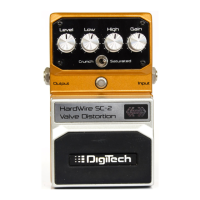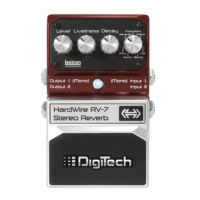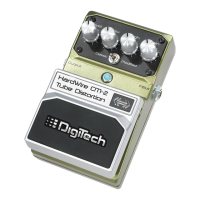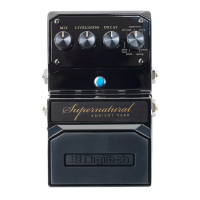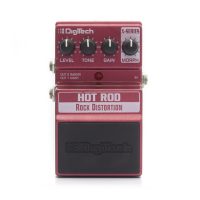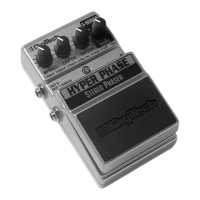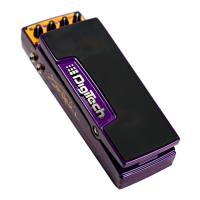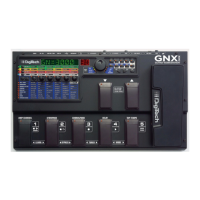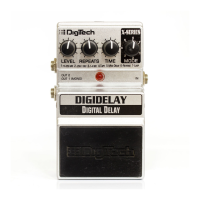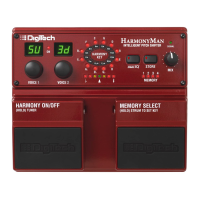
Do you have a question about the DigiTech HARMONYMAN and is the answer not in the manual?
| Technology | Digital |
|---|---|
| Power Supply | 9V DC |
| Harmony Voices | 2 |
| MIDI | No |
| Type | Harmony |
| Inputs | 1 x Instrument |
| Outputs | 1 x Instrument |
Explains safety symbols and general precautions for electrical products like not opening the unit or exposing it to moisture.
Details power cord wire color coding (Green/Yellow, Blue, Brown) and correct terminal connections for safety.
Lists essential safety instructions for operating the apparatus, including ventilation, heat, attachments, and storm precautions.
Outlines conditions for EMC compliance and recommends using only shielded interconnecting cables for optimal performance.
Warns against using damaged or cut mains plugs and emphasizes fuse cover safety for 13 Amp sockets.
Declares product conformity with safety and EMC directives, listing manufacturer details and compliance specifications.
Outlines warranty terms, including registration, defect coverage, liability limits, proof of purchase, and exclusions.
Notifies users that manual information is subject to change and may not reflect all undocumented product updates.
Introduces the HarmonyMan, lists included items, and highlights its key features and benefits for guitarists.
Explains the Harmony Key Display for indicating key/scale and the musIQ button for automatic key detection.
Details the Memory Store button for saving settings and the Signal LED for indicating guitar input levels and clipping.
Explains the Mix knob for adjusting the blend of lead and harmony signals and the Memory LEDs indicating active memory presets.
Describes the Memory Select footswitch for cycling presets and the Tuner Display for checking pitch accuracy.
Explains the Harmony On/Off footswitch for engaging/bypassing harmonies and the Voice Knobs for selecting harmony voicings.
Explains the On LED as a harmony indicator and the Voicing Displays showing the selected harmony settings.
Details the Guitar Clean Input jack, used for chord recognition and generating harmonies when no distortion return is connected.
Explains the Distortion Send/Return jacks for integrating distortion effects before harmony generation.
Describes the optional Sidechain Input for dynamic harmonies and the Sidechain Thru for passing a clean signal.
Explains the Ground Lift button for hum reduction and the Main Outputs for mono or stereo signal routing.
Specifies the Power Supply Jack for connecting the included power adapter.
Provides step-by-step instructions for connecting the HarmonyMan to your guitar, amplifier, and power source.
Guides users on setting input signal levels using the Signal LED and tuning their guitar using the built-in tuner.
Explains how to use the Voice 1 and Voice 2 knobs to select different harmony voicings.
Details how to set the key and scale either automatically using musIQ or manually by strumming a chord.
Provides steps for automatically detecting the song's key and scale using the musIQ feature with a single guitar.
Explains the process of manually setting the key and scale by holding the Memory Select footswitch and strumming a chord.
Describes how to reset the musIQ feature's memory to re-enable automatic key detection and clear historical data.
Guides on enabling harmonies and playing a solo, adjusting the mix between lead and harmony signals.
Explains how to store current voicings, mix levels, and key settings into one of the four available memory locations.
Details how to recall stored settings from any of the four memory locations using the Memory Select footswitch.
Describes triad-centered harmonies based on root, 3rd, and 5th structures, optimized for major/minor scales and chord progressions.
Explains intelligent scalic shifting, creating harmonies within the current key, including fixed octave shifts.
Details fixed shifting, which transposes all notes by a constant number of semitones regardless of the input note or key.
Describes detune shifting for a thicker sound, where voices are detuned slightly in opposite directions.
Shows example harmony notes generated for C Major and A Minor scales with Triad-Centered and Scalic voicings.
Explains how to use the table to find HarmonyMan key/scale settings corresponding to different musical modes.
Details how musIQ analyzes the guitar signal to determine key/scale when only one guitar is connected.
Explains how sidechain input is used to determine key/scale and dynamic harmonies with rhythm guitar input.
Summarizes musIQ behavior with and without sidechain input, for both harmony effect states.
Illustrates a connection setup for an electric guitar using distortion before the HarmonyMan pedal.
Shows a connection diagram using the amplifier's send/return loop for integrating distortion effects.
Depicts a setup with two guitars, one for rhythm (sidechain) and one for lead with pre-harmony distortion.
Illustrates how to connect an acoustic guitar directly to a mixer or PA system for sound reinforcement.
Addresses issues with the Harmony Key Display showing a set key after reset and unexpected key suggestions from musIQ.
Explains why the Harmony Key Display may not react to chords and the effect of the Sidechain Input on key detection.
Details the technical specifications for all input and output connections of the HarmonyMan pedal.
Provides specifications for audio performance (sample rate, bit depth) and power requirements (voltage, consumption).
Lists general physical specifications such as dimensions and weight of the HarmonyMan unit.
